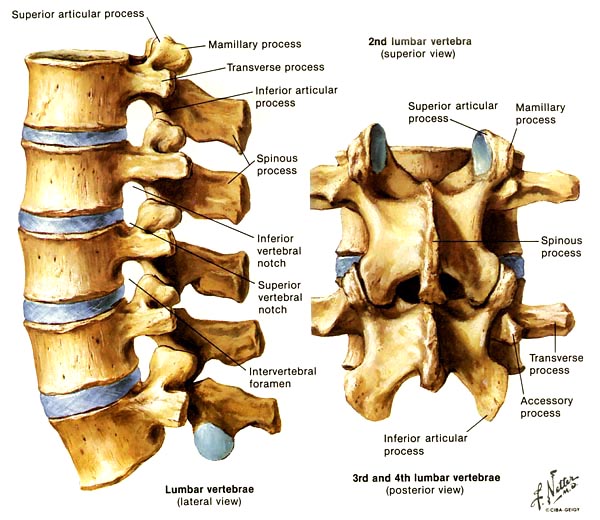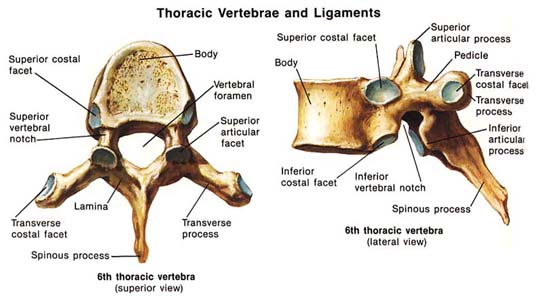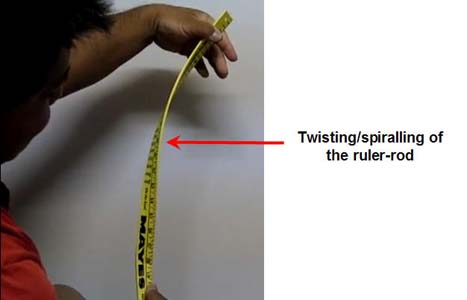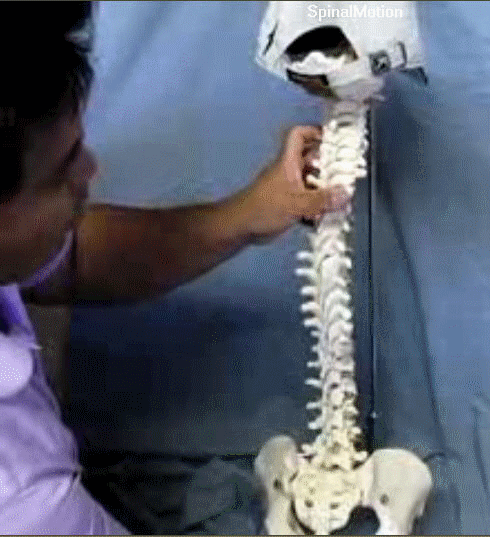|
|
Post by vjsinger on May 28, 2010 18:58:38 GMT -5
Is it or is it not capable of rotation? I ask, because Jeff says it isn't in his hip pivot movements review paper and I've read that it actually is. From Jeff's paper:
[glow=red,2,300]The lumbosacral joint area is where the lumbar spine (lower 5 vertebrae of the spinal column) attaches to the pelvis (sacrum). There is no movement at the lumbosacral joint, and it is a "fixed' joint. The lumbar vertebrae are incapable of rotatory movement, and the lumbar spine can only flex forward (lumbar flexion) and slighly backwards (lumbar hyperextension). [/glow]
From Wiki on the Lumbar vertebrae:
These five (5) vertebrae are very robust in construction, as they must support more weight than other vertebrae. They allow significant flexion and extension, moderate lateral flexion (sidebending), and a small degree of rotation. The discs between these vertebrae create a lumbar lordosis (curvature that is concave posteriorly) in the human spine
|
|
|
|
Post by nothere on May 28, 2010 20:00:07 GMT -5
Is it or is it not capable of rotation? I ask, because Jeff says it isn't in his hip pivot movements review paper and I've read that it actually is. From Jeff's paper: [glow=red,2,300]The lumbosacral joint area is where the lumbar spine (lower 5 vertebrae of the spinal column) attaches to the pelvis (sacrum). There is no movement at the lumbosacral joint, and it is a "fixed' joint. The lumbar vertebrae are incapable of rotatory movement, and the lumbar spine can only flex forward (lumbar flexion) and slighly backwards (lumbar hyperextension). [/glow] From Wiki on the Lumbar vertebrae: These five (5) vertebrae are very robust in construction, as they must support more weight than other vertebrae. They allow significant flexion and extension, moderate lateral flexion (sidebending), and a small degree of rotation. The discs between these vertebrae create a lumbar lordosis (curvature that is concave posteriorly) in the human spine They can to a small degree, average is 0.8 degrees , max is 5.6 degrees. Is this important to a golfers pivot or just interesting info? or....? |
|
|
|
Post by vjsinger on May 28, 2010 20:48:35 GMT -5
A sudden interest in my posts nothere, weird timing hmmmm. There is no underlying thing here to try and make anyone look bad. I actually thought maybe Jeff made a typo or something, but I don't know. I wasn't a doctor and I think he was. I'm also reading some stuff from Kelvin Miyahira and I'm confused about some things he puts out there, but that question is coming soon. Where did you get those numbers?
|
|
|
|
Post by nothere on May 28, 2010 22:04:10 GMT -5
A sudden interest in my posts nothere, weird timing hmmmm. There is no underlying thing here to try and make anyone look bad. I actually thought maybe Jeff made a typo or something, but I don't know. I wasn't a doctor and I think he was. I'm also reading some stuff from Kelvin Miyahira and I'm confused about some things he puts out there, but that question is coming soon. Where did you get those numbers? I got the info off a website that talks about a study of lumbar rotation just google lumbar rotation and you can find what your looking for. As for weird timing of my"sudden interest" in your posts i find that statement, weird hmmm... have no idea what your implying. I guess Jeff or Iteachgolf could ask me the same question and they get the same answer i gave you. I just thought that it had something to do with the pivot and was interested but if you don't want me to comment on your posts that's no problem. Good luck with the knee. |
|
|
|
Post by imperfectgolfer on May 29, 2010 10:11:34 GMT -5
 Check the anatomical features of the inter-facet joints of the lumbar vertebra. That should allow one to understand why the lumbar spine is not designed for a rotary motion. One can get about 0.8 degrees of rotation at each lumbar joint level (on average), but golfers with lax joints may get 2 degrees of rotation per lumbar joint level. That amount pales in comparison with the amount of rotation possible at the level of the lower-mid thoracic spine.  Note that the superior and inferior articular facet joint surfaces of the thoracic vetebra are flat - like shingles on a roof - and that allows each thoracic vertebra to rotate more freely about the longitudinal axis of the spine. Jeff. |
|
|
|
Post by vjsinger on May 29, 2010 10:37:28 GMT -5
|
|
|
|
Post by gmbtempe on May 29, 2010 11:38:43 GMT -5
Those are great questions VJ, I will have to read through everything on you links but the first video...........I am having a hard time imagining that the "spine" itself provides power by coiling and uncoiling like a rubber band. I would imagine the spine provides the infrastructure but the muscles attached to the body are what is coiling and uncoiling.
I will wager though that Jeff knows.
Either way Kelvin does great stuff on his site.
|
|
|
|
Post by nothere on May 29, 2010 11:51:57 GMT -5
Is there scientific evidence to support Kelvin's opinion on a " spine engine" ? If so how can it be used on demand? Sounds like another unproven theory. How much more speed can you get from this, is there data to show the increase? Weird hmmm... |
|
|
|
Post by imperfectgolfer on May 29, 2010 12:10:17 GMT -5
It is interesting that Kelvin posted this spine engine article this month. Last month, we had extensive communication (including cc copies of our e-mails to Gracovetsky) about spine mechanics. I disagree with any "spine engine" theory that proposes that there is enough laxity in the lumbar spine to allow for an elastic recoil phenomenon - according to the spine engine theory. In fact, I think that Kelvin's many photos demonstrate a point that I have always made - the pelvis and sacrum and lumbar spine rotate together as an unitary structure. That allows pelvic (lower body) motion to passively transfer a force to the upper torso, that induces the upper torso to also start rotating. However, any side-tilting (lateral bending) of the torso occurs due to rotary motions involving the lower-mid thoracic spine. Regarding the speedchain video, he shows the lumbar spine being more "locked" from a rotary motion perspective when it is in lordosis, and he states that lumbar spine hyperflexion disengages the lumbar interarticular facet joints. However, I think that his claim is untrue because one cannot disengage those interfacet joints very much due to the presence of many tight ligaments around those joints (especially when those ligaments become calcified with age). Secondly, Kelvin seems to be misusing the term "lordosis" in his explanation. Lordosis only applies to movements of the lumbar spine in the sagittal plane and there cannot be any concept such as left and right lordosis. He shows a photo of Tiger having some lateral bending of the mid-torso and he calls this lordosis. I think that this description is totally incorrect. That lateral bending is due to the fact that the rotary motion of the torso is primarily occurring at the level of lower-mid thoracic spine (relative to the lumbar spine and sacrum) and that differential motion causes the torso to acquire that visual appearance of lateral/side bending. Tom Agricola doesn't have the mid-lower thoracic spine latriflexion-rotation flexibility to allow his mid-torso to acquire that "side-bending" appearance (which Kelvin incorrectly calls "lordosis"). I also do not believe that one generates swing power at impact (or near-impact) by any elastic recoil motions occurring at the level of the lumbar spine and sacrum. I believe in HK's power accumulator loading/release concept, and I believe that the pivot action induces the release of PA#4 in the early-mid downswing. Once PA#4 is released, PA#2/3 release will occur automatically/naturally according to the laws of physics (passive release via the law of the flail). I also believe that many golfers have a "standing-up" problem at impact due to a failure to maintain their spinal bend posture and due to a failure (or inability) to "correctly" latriflex the mid-torso via latriflexion/rotation movements occurring at the level of the lower-mid thoracic spine (and not at the level of the lumbar spine). The mid-spine must latriflex-rotate to allow the spine to bend - like that flexible ruler-rod (shown in the Speedchain video).  However, it is important to realize that this twisting-spiraling motion of the spine occurs at the level of the level of the mid-lower thoracic spine (and not the lumbar spine) and the twisting load is distributed over many vertebra. Also, power is not generated by elastic recoil (like a stretched rubber band recoils). Pivot action power comes from mid-upper torso muscles that twist/untwist the torso, and the spine must allow that phenomenon to happen. However, that doesn't mean that the "spine engine" is generating the pivot-action power via an elastic recoil phenomenon (like a stretched rubber band recoils). Jeff. |
|
|
|
Post by nothere on May 29, 2010 12:44:30 GMT -5
It is interesting that Kelvin posted this spine engine article this month. Last month, we had extensive communication (including cc copies of our e-mails to Gracovetsky) about spine mechanics. I disagree with any "spine engine" theory that proposes that there is enough laxity in the lumbar spine to allow for an elastic recoil phenomenon - according to the spine engine theory. In fact, I think that Kelvin's many photos demonstrate a point that I have always made - the pelvis and sacrum and lumbar spine rotate together as an unitary structure. That allows pelvic (lower body) motion to passively transfer a force to the upper torso, that induces the upper torso to also start rotating. However, any side-tilting (lateral bending) of the torso occurs due to rotary motions involving the lower-mid thoracic spine. Regarding the speedchain video, he shows the lumbar spine being more "locked" from a rotary motion perspective when it is in lordosis, and he states that lumbar spine hyperextension disengages the lumbar interarticular facet joints. However, I think that his claim is untrue because one cannot disengage those interfacet joints very much due to the presence of many tight ligaments around those joints (especially when those ligaments become calcified with age). Secondly, Kelvin seems to be misusing the term "lordosis" in his explanation. Lordosis only applies to movements of the lumbar spine in the sagittal plane and there cannot be any concept such as left and right lordosis. He shows a photo of Tiger having some lateral bending of the mid-torso and he calls this lordosis. I think that this description is totally incorrect. That lateral bending is due to the fact that the rotary motion of the torso is primarily occurring at the level of lower-mid thoracic spine (relative to the lumbar spine and sacrum) and that differential motion causes the torso to acquire that visual appearance of lateral/side bending. Tom Agricola doesn't have the mid-lower thoracic spine latriflexion-rotation flexibility to allow his mid-torso to acquire that "side-bending" appearance (which Kelvin incorrectly calls "lordosis"). I also do not believe that one generates swing power at impact (or near-impact) by any elastic recoil motions occurring at the level of the lumbar spine and sacrum. I believe in HK's power accumulator loading/release concept, and I believe that the pivot action induces the release of PA#4 in the early-mid downswing. Once PA#4 is released, PA#2/3 release will occur automatically/naturally according to the laws of physics (passive release via the law of the flail). I also believe that many golfers have a "standing-up" problem at impact due to a failure to maintain their spinal bend posture and due to a failure (or inability) to "correctly" latriflex the mid-torso via latriflexion/rotation movements occurring at the level of the lower-mid thoracic spine (and not at the level of the lumbar spine). The mid-spine must latriflex-rotate to allow the spine to bend - like that flexible ruler-rod (shown in the Speedchain video).  However, it is important to realize that this twisting-spiraling motion of the spine occurs at the level of the level of the mid-lower thoracic spine (and not the lumbar spine) and the twisting load is distributed over many vertebra. Also, power is not generated by elastic recoil (like a stretched rubber band recoils). Pivot action power comes from mid-upper torso muscles that twist/untwist the torso, and the spine must allow that phenomenon to happen. However, that doesn't mean that the "spine engine" is generating the pivot-action power via an elastic recoil phenomenon (like a stretched rubber band recoils). Jeff. Very well explained by someone who knows. Thanks Jeff . |
|
murf65
Beat up Radials

Posts: 10
|
Post by murf65 on May 29, 2010 17:03:07 GMT -5
Are you guys serious with this stuff? No disrespect intended, but this sort of thinking will ruin my game. I am gone.
|
|
|
|
Post by imperfectgolfer on May 29, 2010 17:19:40 GMT -5
I took that speedchain spinal motion swing video, and used it to create this animated gif.  Note that virtually all the spinal rotary motion only involves the thoracic and cervical spine. Note that the lumbar spine and sacrum only rotate as much as the pelvis (and at the same rate of rotational speed). Jeff. |
|
|
|
Post by vjsinger on May 29, 2010 17:44:40 GMT -5
Huh....sure does. Great work Jeff, thanks!
|
|
|
|
Post by nothere on May 29, 2010 18:48:11 GMT -5
|
|
|
|
Post by gmbtempe on May 29, 2010 19:14:38 GMT -5
Are you guys serious with this stuff? No disrespect intended, but this sort of thinking will ruin my game. I am gone. good bye |
|